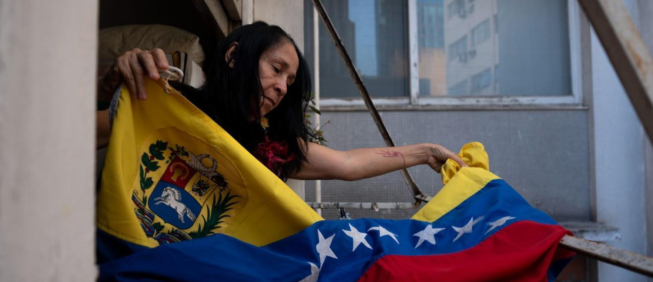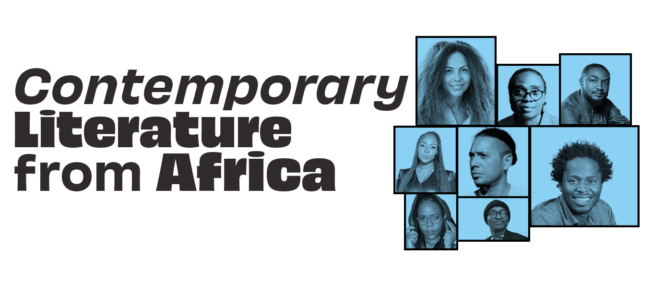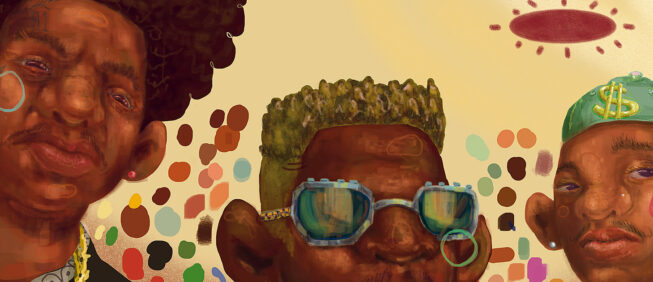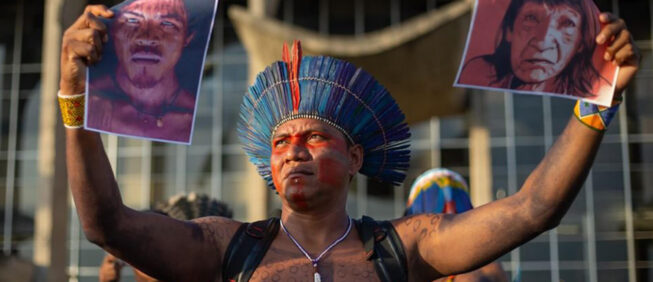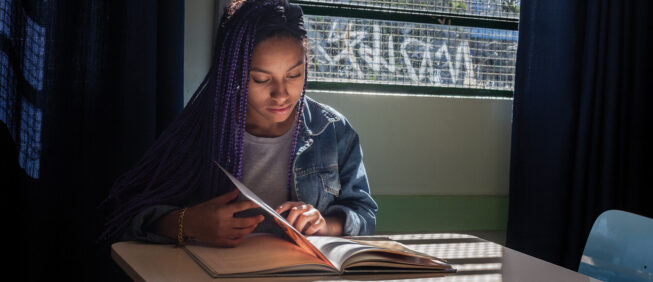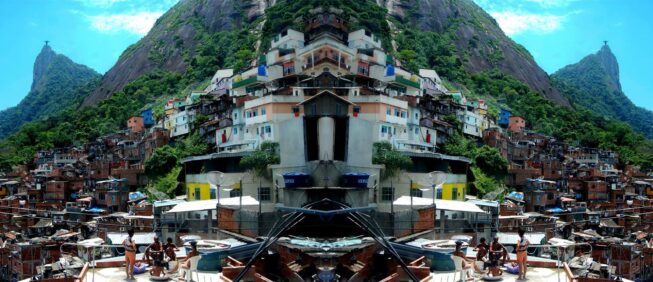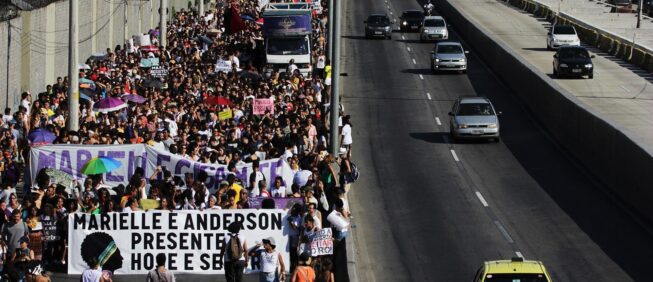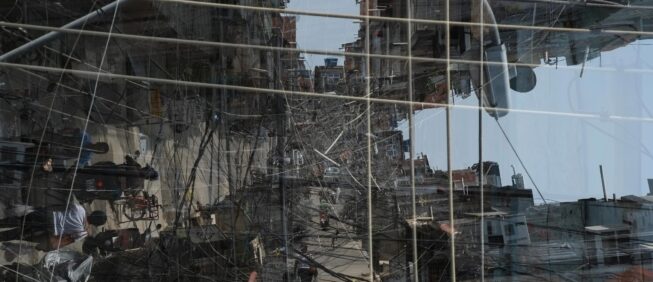Who is afraid of a black boy who is free, educated and alive?
Body — the territory of minor offenders — and the proposals of the HONEPO — Black Men in Politics — collective
Osmar Paulino
| Brazil |
January, 2023
translated by Nicole Froio
Abstract
HONEPO is a collective, composed of several black men located in different states of Brazil, which aims to create, through data, discourses about the black man, taking insights from the multiple skill sets of our members and the social needs in their territories, and recruiting political candidates committed to the black, marginalized and democratic agenda to the legislative and executive branches in all spheres.
The demographic profile of adolescents assisted by the units of the General Department of Socio-Educational Actions (DEGASE) between January 2018 and September 2020 is as follows: 94% are black boys, on average aged 16, as shown by data from the Public Ministry of Rio de Janeiro. These boys are also part of the 71.7% of teenagers who drop out of school the most, according to data from the Brazilian Institute of Geography and Statistics (IBGE) for 2020. Cross-comparing this data will result in the obvious and tough reality that black boys have to face.
Most of them drop out of school due to the need to work, invariably, in informal jobs such as bagging groceries in supermarkets, watching over cars and bicycles, selling sweets at traffic lights, among others. This dynamic makes this being vulnerable as soon as he is apprehended by institutions that provide socio-educational services or when he is existing completely outside traditional education paths, or outside the formal labor market and, consequently, staying distant from, as adults, the political system of the country. It is in this intersection of forces, interests and historical processes that HONEPO (Black Men in Politics) has been created.
HONEPO is a collective composed of several black men located in different states of Brazil, which aims to create, through data, discourses about the black man, focus on the multiple skills of our members and social needs in their territories and train political candidates committed to the black, peripheral and democratic agenda, to insert them in the legislative and executive branches of government. With this, HONEPO envisages significantly improving the lives of black boys, young people and men, whether by creating possibilities with them in their territories, or by preparing people to represent their interests in institutional politics.
Black boys are the main targets of biopolitics, that is, the mass control of bodies, perpetrated by various government agencies. Mass control over their bodies, where they should or should not be, is evident when we consider that 76.2% of people murdered in Brazil are black, according to 2020 data from the Brazilian Public Security Forum. Additionally, 54.3% of these murdered black people are young, 91.3% of which are young black males.
This data, which are taken from the Infographic on the Situation of the Black Man in Brazil produced by HONEPO, demonstrates that because of this relationship based on [state] control, young black men are pushed into a zone of non-being, as pointed out by Dr. Franz Fanon in his book Black Skin, White Masks. That is, the dignity of young black people is reduced by the State. This dynamic takes place in the sphere of the body and the subjective construction of the black boy whose body is displaced from the logic of humanization.
Therefore, for this being, the objective attributes that will guarantee him the full exercise of citizenship, such as high quality formal education, healthcare and leisure, for example, are denied him since he does not fit, according to the segregation of society, within the category of the human being. As a territory, the black boy's body is in constant dispute for power, whether symbolic or material. When we talk about the black young man, we are talking about a multi-territorialized body. The dispute for symbolic power, based on the black boy's body, can be analyzed from the image of representation, and this becomes evident when we research the various cinematographic productions that deal with violence and drug trafficking, or even the literary productions.
In almost all of these cases, the young black person is the person who will represent the marginalized characters. As examples, we can mention the films Pixote, a lei do mais fraco [Pixote, the law of the weakest] (1980) directed by Hector Babenco; Cidade de Deus [City of God] (2002) directed by Kátia Lund and Fernando Meirelles; Alemão (2014) directed by José Eduardo Belmonte, among other films. In these cinematographic productions, the marginal characters are all black and young, with a life trajectory marked by the presence of public powers, most of the time, represented by the police force. This imagery represents black bodies in the position of those who must be controlled, exterminated, as they create the reasoning of fear, dread, difference, incomprehension and savagery.
On the other hand, the heroic characters, almost always played by white actors, are given the representation of the savior, the one who will control, exterminate. On the other hand, the heroic characters, almost always played by white actors, are given the role of the savior, the one who will control, exterminate. It is he who has the courage to face the difference, the savage with strength, invariably. The understanding of the material relationship of the body of the young black person with power is the realization of the control of these bodies, either through apprehension, limiting their freedom, or through murders, or subjugating them to a lack of access to culture and education — which will become a problem for them as workers, because a small repertoire of formal training, manual and precarious work activities will remain [his only options] — is one of the main causes for dropping out of school.
It is important to emphasize that the multi-territory that is the body of these black boys acts on a spatial substrate where a series of objects and many other power relations are constructed, that is, these black bodies, in a dialectic, are produced and produce the geographic space in which they are inserted. Therefore, they are places where a series of life experiences take place. These places, resulting from a historical construction, are almost always the favelas and outskirts of the city, that is, in places with a high concentration of black boys.
It is not by chance that this is the context of the mentioned films, where, in a consensual and social way, absences from public services take place. That is, these places are transformed into zones of sacrifice. According to the 2018 Oxford Language Dictionary, the word “sacrifice” means “ritual offering to a deity that is characterized by the real or symbolic immolation of a victim or the delivery of the thing offered”. Based on this definition, we can say that the disregard for the favelas and peripheries and, consequently, for black boys, is a kind of symbolic offering (constructions of narratives and discourses about the favela and about these boys) and real, to a kind of deity that benefits from the misery of it all. Here we have to reflect on the scope of the sacrifice zone.
It is impossible for black boys to live in these places and not be affected by the same sacrifices, that is, within a life experience, it is completely understandable that the subject and the place they relate to are confusing, given the levels of interactions between them. Furthermore, since the zones are sacrificed to other interests, the black children who live in them will evidently also be sacrificed.
It is then up to us to ask: who is afraid of the black boy who is alive, educated and free? Well, we could come up with some answers; in the economic field, financial capital; in the social field, the elite itself; in the cultural field, the institutions and people who hold the power to create discourses about Brazil. However, it seems to me that all these responses do not present a fundamental reason in themselves for being the most consistent with this framework. Faced with the challenge to seek a concept that can explain all possibilities, I find racism as a conceptual keyword that could be the foundation of our investigation.
Racism is afraid of the black boy who is alive, educated and free. According to Kwame Turu and Chales Hamilton, authors of the book Black Power (1970), racism is much more than the action of individuals with personal motivations; racism is infiltrated in institutions and culture, generating a priori deficient conditions for a large part of the population, where black boys are inserted. That is, racism constitutes a system in which a portion of society has privileges because of its race, and this system is maintained by a structure (it is very important to understand culture here as a great, if not the main, promoter of this structure, given the examples of the films mentioned) and by institutions, both private and multinational and public sectors, such as the judiciary branch, for example.
Racism acts to serve the interests of capitalism, that is, to meet the logic of segregating people, of putting black children in the zone of non-being, of transforming their places of coexistence and, consequently, themselves, into zones of sacrifice, so that some people can accumulate capital.
If the young black body is a territory, it is necessary to say that it is in constant dispute and that it is made, mainly, by the black boys themselves, when, through cultural manifestations, such as passinho do funk1the “passinho do funk” is a kind of dance invented by black boys in working class neighborhoods in Brazil. There’s no available translation that fully captures the concept., funk music that is played at 150 beats per minute, the nights out, etc., they resignify their own bodies at the face of a logic of devaluation of their lives in a movement to create new zones of existence where their bodies find a place. When these movements happen, often the favelas and outskirts of the cities, where these boys live, also gain new imagery that represents them, and consequently, these spaces are starting to be considered as places of potencies.
An example of this is Voz das Comunidades [Voice of the Community], a community journalism collective created by Renê Silva, which portrays the favelas of Rio de Janeiro from the point of view of favela residents. Jailson de Souza e Silva conceptualizes this phenomenon as a paradigm of power in A favela reinventa a Cidade [The favela reinvents the city] (2020): despite the policy of neglect enforced by public powers, the favela and the periphery reinvent themselves from their most fundamental element, which is the population itself, in which the black boy is also included.
There is no doubt that well-designed public policies aimed at serving young black people in the field of education, sports, healthcare, food, employment and income would optimize the potential of black boys from the favelas and peripheries. It would humanize them and take them out of the zone of non-being. It would provide black boys with living spaces that aren’t structured by sacrifice. But for that, it is necessary to put an end to racism. It is impossible to talk about public policies that serve black boys without talking about the end of racism that structures society and institutions, which interferes with the development of Brazilian democracy, because it is not possible to discuss a Democratic State of Law with such disparities that surround Brazilian black boys.
For this end, it is necessary to elect political agents from favelas and peripheries, political agents who are black, indigenous and committed to the periphery. Therefore — HONEPO — Homens Negros na Política [Black Men In Politics].

Osmar Paulino | Brazil |
Coordinator of HONEPO and creative director and curator of FAIM - Festival de Artes de Imbariê.

